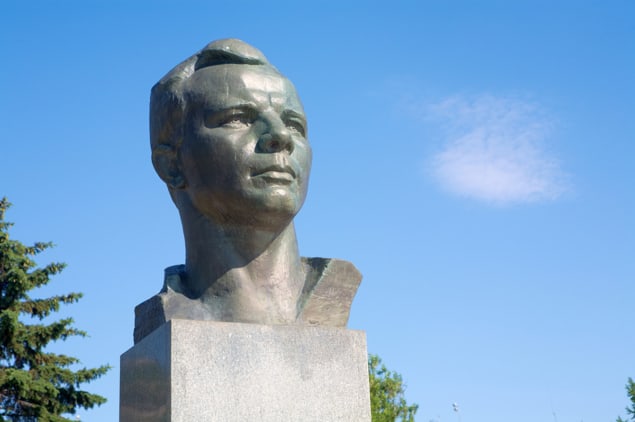Margaret Harris reviews Cosmonaut: a Cultural History by Cathleen S Lewis

On 12 April 1961 Yuri Gagarin became the first human to orbit the Earth, launching into space in his Vostok-1 craft with an enthusiastic shout of “Poekhali!” (“Let’s go!”). A quarter of a century later, and more than a decade after Gagarin’s death, his “Poekhali!” was considered so iconic that Soviet media included it in the opening sequence for the country’s nightly TV news programme. By the early 2000s, though, the fall of the Soviet Union had taken some of the shine off Gagarin’s legacy. When a survey (one of several carried out in Russia by local newspapers on anniversaries of Gagarin’s flight) asked students in Siberia to name the person who said “Poekhali!”, a 12-year-old boy called Vasia Maskalov suggested it might have been the Formula One driver Michael Schumacher.
The 40-year period between Gagarin’s triumph and Maskalov’s ignorance of it offers rich pickings for Cathleen S Lewis’ book Cosmonaut: a Cultural History. As a Soviet and Russian specialist at the US National Air and Space Museum, Lewis has a keen eye for differences between the rival Cold War space programmes. After noting in her introduction that American astronauts were required to have what the journalist and author Tom Wolfe termed “the Right Stuff”, Lewis coins a similar phrase for their Soviet counterparts. Cosmonauts, she writes, were expected to have “the Red Stuff” – a nebulous set of qualities that owed as much to Russian ideals (the association between red and Russia predates Lenin) as to Communist ones.
According to Lewis, the differences between the Right Stuff and the Red Stuff played out in several ways. Although the Americans and the Soviets both chose their early space farers from shortlists heavily (and, in the US, completely) dominated by military pilots, the first cosmonauts were too young to have fought in the Second World War. Instead, their authorized biographies emphasized their wartime experiences as children who suffered alongside every other Soviet citizen. Hence, if America’s astronauts were lionized as heroic individuals, the early cosmonauts were promoted as heroic everymen (and, in one case, everywoman).
For the Soviet leadership, the Red Stuff also made cosmonauts a convenient new focus for the personality cult that formerly centred on Josef Stalin. The ruthless dictator’s posthumous fall from favour coincided with the rise of the Soviet space programme, and both were strongly linked to his successor Nikita Khrushchev, who used the cosmonauts’ accomplishments to buttress his domestic and international support. Luckily for Khrushchev, the propagandists were pushing at an open door; in Lewis’ view, people would have adored Gagarin and his colleagues even without official encouragement.
Curious as to how far this sentiment penetrated, I asked a friend who grew up in Soviet-controlled Lithuania (and who, accordingly, detests the Soviet Union and all it stood for) what she remembered about Gagarin. “He was a hero,” she texted back. “Boys wanted to be cosmonauts when they grew up.” The cosmonauts’ achievements, she added, were viewed as “genuinely impressive” – even though “you could go to prison for joking about Gagarin”.
If Kennedy-era NASA officials felt that women didn’t have the Right Stuff, why did their counterparts in Khrushchev’s space programme come to such a different conclusion about women and the Red Stuff?
For me, the most fascinating chapter of Cosmonaut focuses not on the first man in space, but the first woman. Valentina Tereshkova’s history-making flight came barely two years after Gagarin’s, and I have often wondered why it took more than two decades for the US to repeat this Soviet “first”. If Kennedy-era NASA officials felt that women didn’t have the Right Stuff, why did their counterparts in Khrushchev’s space programme come to such a different conclusion about women and the Red Stuff?
The answer, Lewis suggests, is complicated. “According to Communist Party doctrine, there was equal opportunity to toil and labour for women in the USSR,” she writes. “The repeated need to demonstrate that equality indicated that reality was far different.” Although Soviet women flew combat missions, commanded partisan bands and directed factories during the Second World War, by the early 1960s a patriarchal backlash was in full swing. Like their Western counterparts, Soviet women were under enormous pressure to give up their former leadership roles in favour of men. They were also urged to have lots of babies (to replace the 11 million Soviet soldiers and perhaps 20 million civilians who died during the war) and to continue doing low-level work (because the staggering loss of life meant there wasn’t anyone else to do it).
Tereshkova’s flight was thus simultaneously the last gasp of wartime feminism; a means of pretending that the Soviet Union was winning the race for equality at the same time as it was dominating the space race; and a patronizing way to suggest that Soviet spacecraft were so well-designed that even a woman could fly them.
Lewis is a museum curator, and substantial portions of her book focus on the material artefacts of cosmonaut culture. For non-specialist readers, these lengthy discussions of cosmonaut-themed stamps, collectible badges and other memorabilia may have limited appeal. Similarly, I could have done without the summaries that appear at the beginning and end of each chapter, as well as in the introduction and epilogue. A more interesting option for the latter might have been to explore what cosmonaut culture looks like in today’s Russia – something that Lewis, who has clearly put in the hard yards in the Soviet and Russian archives, is well placed to do. Alas, though she notes in passing that “the Putin government has not enthusiastically and wholeheartedly embraced the Red Stuff”, she never explains why this is so. It’s a disappointing omission, and it means that, like the Soviet space programme itself, Cosmonaut peters out rather than living up to its early promise.
- 2023 University Press of Florida 324pp £37.95/$38.00hb



